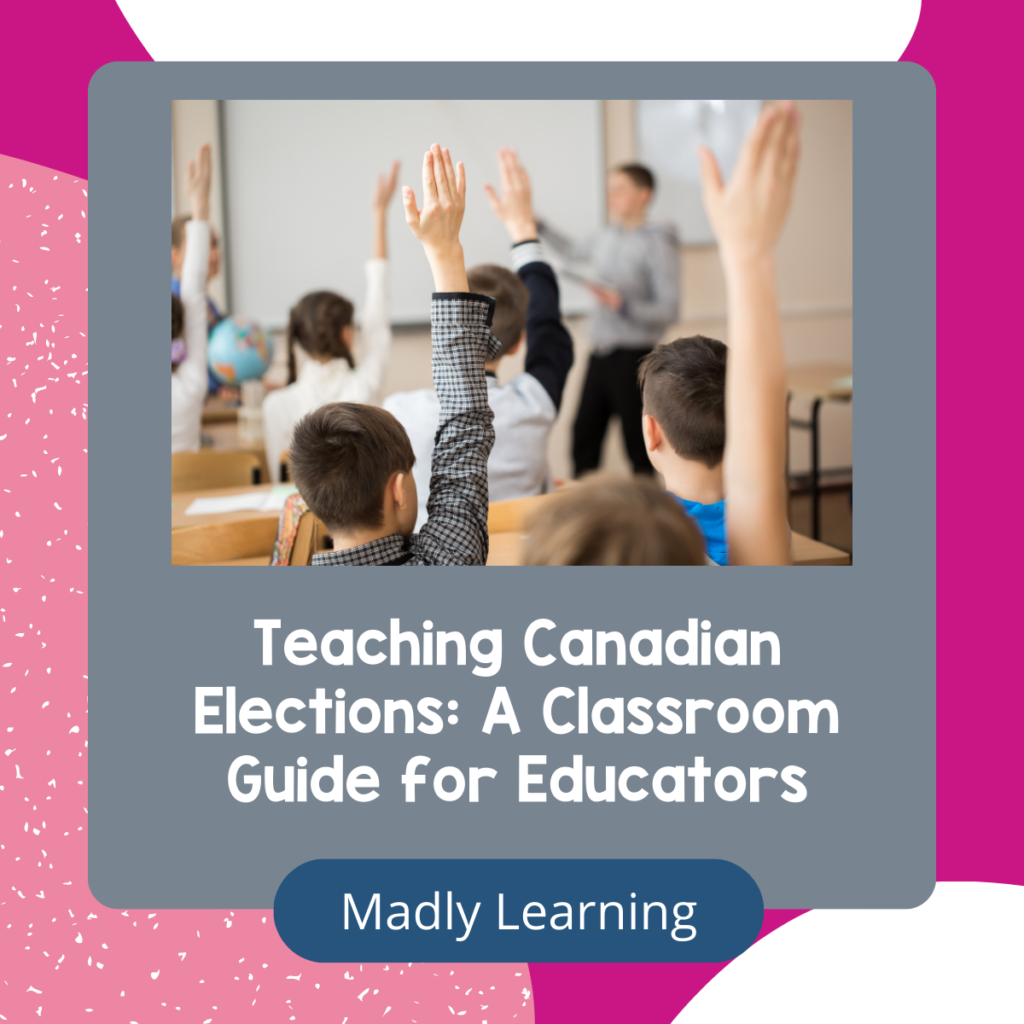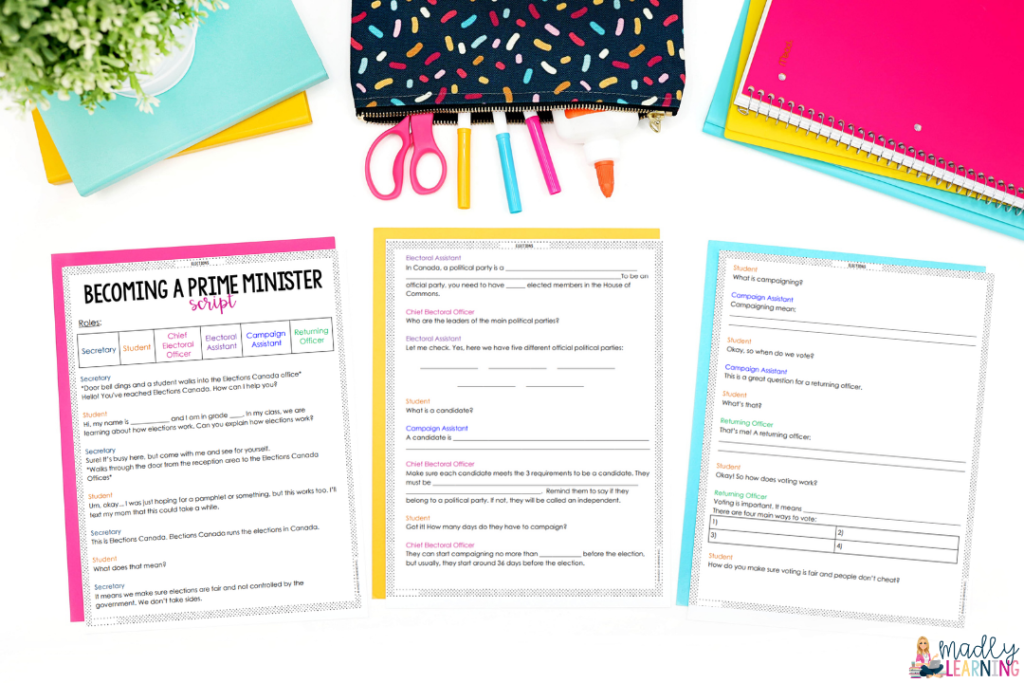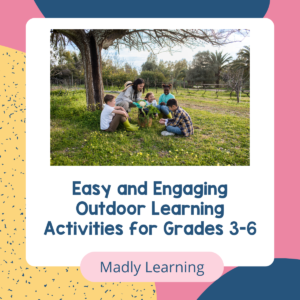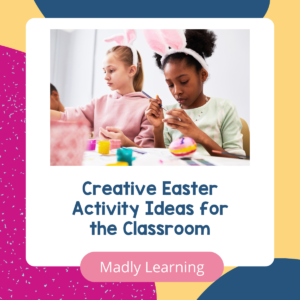With a federal election on the horizon, there’s no better time to start teaching Canadian elections in your classroom. Helping students understand how elections work, what political parties stand for, and the role citizens play in a democracy is a key part of the social studies curriculum—and a vital life lesson.

This post will give you a breakdown of what to teach, how to stay unbiased, and some engaging classroom activities you can try right away. Plus, we’ll share how our Canadian Government & Citizenship resource, the Ignited Lessons Club, and our Spring Teacher Survival Pack can help make your election unit a breeze.
Why Teaching Canadian Elections Matters
Canadian elections are more than just a current event—they’re an opportunity for students to explore big ideas like fairness, civic responsibility, leadership, and representation.
When students understand how our electoral system works, they’re more likely to value their role in democracy as they grow up. It’s also a great opportunity to:
- Build critical thinking skills
- Practice respectful discussion and debate
- Compare different political perspectives
Even younger students can grasp the basics of voting and representation through hands-on simulations and class discussions.
What to Teach About Canadian Elections
Here are some essential concepts to cover when teaching Canadian elections:
- What is a democracy?
- How elections are called in Canada (role of the Prime Minister and Governor General)
- Who runs elections? (Elections Canada)
- How voting works (polling stations, ballots, secrecy)
- What is a riding? and how MPs are elected
- The major political parties and what they stand for
- The role of the Prime Minister
- How a party forms government (majority vs. minority)
Our Canadian Government & Citizenship unit includes student-friendly texts, anchor charts, and visuals to explain each of these in kid-friendly language.
Staying Neutral: How to Teach Elections Without Bias
When teaching Canadian elections, it’s essential to present information in a balanced and factual way. Here are a few tips:
- Use official party platforms and websites to explore the beliefs of each party
- Focus on values and priorities (e.g., environment, economy, education) rather than party loyalty
- Allow students to ask questions and come to their own conclusions
- Avoid sharing your own political views in class
- When discussing controversial issues, guide students to use respectful, evidence-based reasoning
Our election script activity is a great way to role-play the electoral process without assigning real political roles or debate topics. Students act as electoral officers, campaign assistants, or returning officers and walk through how an election is organized in Canada. You can find it in our Ignited Lesson’s Club!
Fun & Engaging Classroom Activities
1: Hold a Classroom Election
Set up your own polling station in class and have students vote on a fun topic (class pet, favourite sport, next class read-aloud). This helps students understand how a ballot works, the role of the returning officer, and how votes are counted.
2: Political Party Research Carousel
Set up stations with simplified party platforms (based on real sources). Have students rotate and summarize what each party believes using a graphic organizer.
3: Map the Election
Use the federal election results to colour-code a map of Canada, showing party representation by province. This visual helps students understand the “first past the post” system and why some provinces appear to favour certain parties.
4: Skit: How to Become Prime Minister
Included in the Spring Teacher Survival Pack, this drama-based activity has students perform a short skit showing how a citizen becomes Prime Minister, from joining a party to campaigning and forming government.
5: Debate or Writing Prompt
Ask: “What qualities make a good leader?” or “Should the voting age be lowered?” Have students write opinion pieces or host a class discussion using sentence starters and respectful dialogue prompts.
Teaching Canadian Elections with Madly Learning
Need everything ready to go? We’ve got three options for you:
1. Canadian Government & Citizenship Unit
Includes:
- Student-friendly readings on elections, leaders, and responsibilities
- Activities to analyze the electoral process
- Writing prompts and research projects
2. Ignited Lessons Club
Our membership gives you access to:
- Full unit on Canadian government
- Classroom activities
- Inquiry-based projects and lesson plans
3. Spring Teacher Survival Pack
Includes a government + drama crossover lesson to teach how elections work through student-led skits and storytelling.
Conclusion
Teaching Canadian elections helps students become informed, responsible, and active citizens. It connects to real life, sparks important conversations, and builds essential thinking skills.
Whether you’re planning a full unit or just looking for a one-day activity, we’ve got you covered with ready-to-use resources, engaging activities, and no-prep printables.






